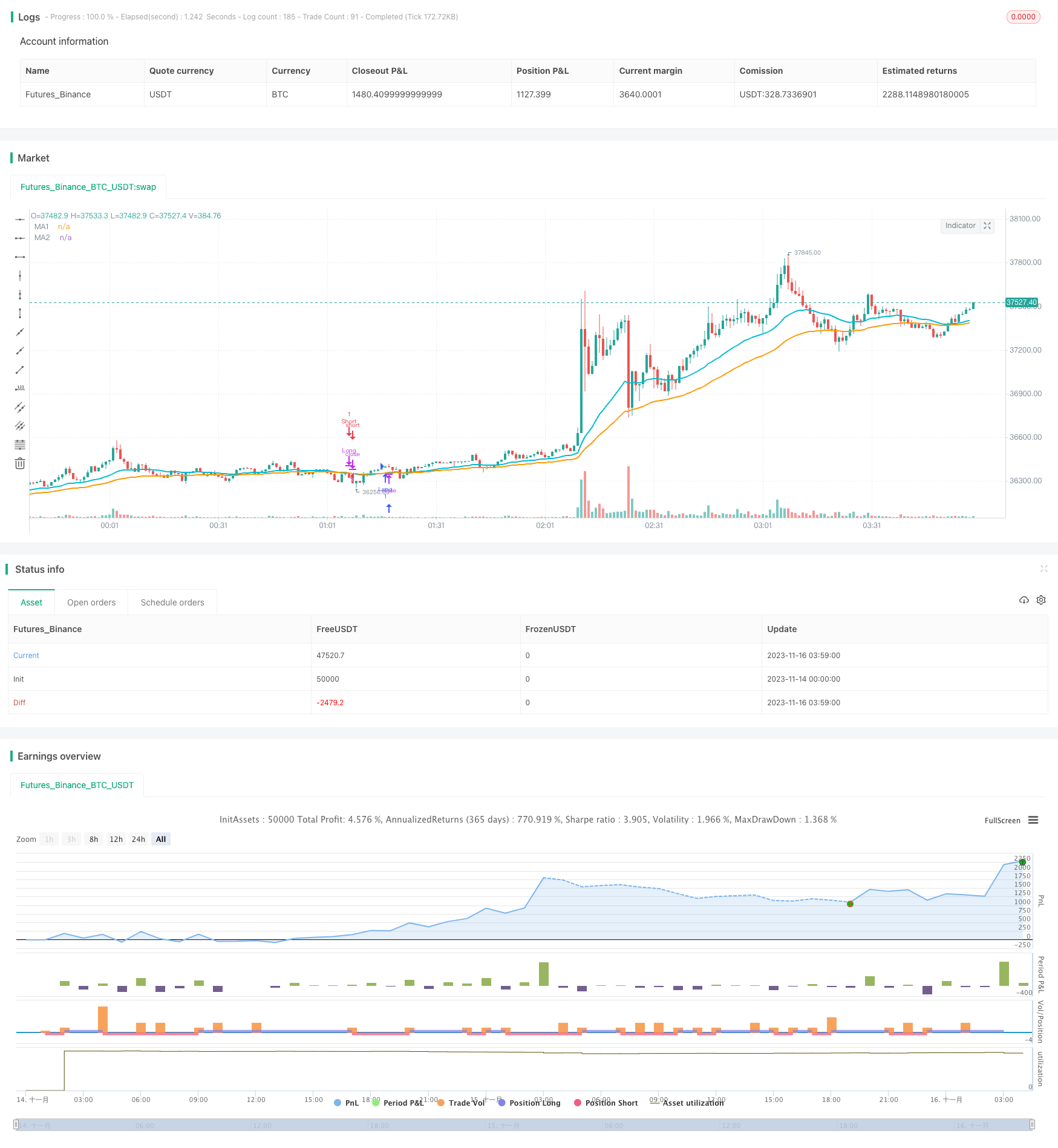Estratégia de cruzamento da média móvel
Autora:ChaoZhang, Data: 2023-11-22 16:38:26Tags:

Resumo
A estratégia de cruzamento da média móvel é uma estratégia quantitativa simples, mas eficaz, baseada em médias móveis. Ela usa o cruzamento de uma linha média móvel rápida e uma linha média móvel lenta para gerar sinais de compra e venda. Quando a linha rápida quebra a linha lenta de baixo, um sinal de compra é gerado. Quando a linha rápida quebra a linha lenta de cima, um sinal de venda é gerado.
Estratégia lógica
A lógica central desta estratégia consiste em usar médias móveis para julgar as tendências do mercado. As próprias médias móveis têm a funcionalidade de filtrar o ruído aleatório do mercado. A média móvel rápida pode responder às mudanças de preço mais rapidamente e refletir as últimas tendências, enquanto a média móvel lenta responde mais lentamente às últimas mudanças de preço e representa tendências de médio a longo prazo. A ruptura da linha rápida através da linha lenta significa que a tendência de curto prazo se inverteu para ser consistente com a tendência de médio e longo prazo, gerando assim sinais de negociação.
Especificamente, esta estratégia define primeiro a média móvel rápida sig1 e a média móvel lenta sig2. Em seguida, os pontos de compra e venda são determinados de acordo com as relações de cruzamento entre sig1 e sig2. Quando sig1 atravessa sig2 de baixo, uma condição longa longCondition é gerada. Quando sig1 atravessa sig2 de cima, uma condição curta shortCondition é gerada. A estratégia então coloca ordens quando as condições longas e curtas são atendidas, e define ordens de stop loss e take profit para sair.
Análise das vantagens
As vantagens desta estratégia são significativas:
- Lógica simples, fácil de compreender e implementar
- Ajuste flexível de parâmetros, pode ser otimizado em diferentes condições de mercado
- Pode ser combinado com outros indicadores para filtrar sinais e melhorar a estabilidade
- Bom desempenho, por exemplo, a combinação EMA15-EMA30 pode alcançar 83% de taxa de vitória nos dados diários do EURCHF
Análise de riscos
Há também alguns riscos com esta estratégia:
- Efeitos graves de serra, configuração de perda de parada é crucial
- Desempenho fraco nos mercados de variação e lateral
- Requer testes extensos e ajuste de parâmetros para se adequar a diferentes produtos e prazos
Medidas de otimização:
- Adicionar outros indicadores para o julgamento para evitar problemas
- Ajustar os tipos e parâmetros de autorização de importação para os diferentes produtos
- Otimizar os índices de stop loss e take profit para controlar os riscos
Conclusão
Em geral, a estratégia de cruzamento de média móvel é uma estratégia de quantidade com lógica simples, praticidade forte e estabilidade. Com ajuste de parâmetros e otimizações adequadas, pode gerar lucros constantes em vários ambientes de mercado. Vale a pena focar e aplicar para os traders quantitativos.
/*backtest
start: 2023-11-14 00:00:00
end: 2023-11-16 04:00:00
period: 1m
basePeriod: 1m
exchanges: [{"eid":"Futures_Binance","currency":"BTC_USDT"}]
*/
//@version=3
// Simple yet effective MA cross strategy.
// You'll have to tune the parameters to get an optimal win ratio.
// If JPY or XAU or any other currency with pips defined as the
// second decimal digit are involved, do not forget to set the respective flag on.
//
// Created by vitelot/yanez/Vts, who's the same fellow with different user names
// December 2018 -- Merry Xmas
//
strategy("MA cross strategy Vts", overlay=true, initial_capital=1000, currency="EUR", pyramiding=0)
yr = input(2016, title="Starting year to analyse")
src = input(close, title="Source")
maType = input( defval="EMA", title="MA Type", options=["SMA","EMA","HMA","McG","WMA"])
//
isJPY = input(false, title="Is JPY or XAU involved?") // JPY and Gold have the pips defined as the 2 decimal digit
maPar1 = input(26, minval=1, title="MA fast period")
maPar2 = input(51, minval=2, title="MA slow period")
atrPar = input(14,minval=1, title="ATR period")
atrMulSL = input(1.5, title="SL ATR multiplicator")
atrMulTP = input(1.0, title="TP ATR multiplicator")
hma(sig, n) => // Hull moving average definition
wma( 2*wma(sig,round(n/2))-wma(sig,n), round(sqrt(n)))
mcg(sig,length) => // Mc Ginley MA definition
mg = 0.0
mg := na(mg[1]) ? ema(sig, length) : mg[1] + (sig - mg[1]) / (length * pow(sig/mg[1], 4))
ma(t,sig,len) =>
if t =="SMA"
sma(sig,len)
else
if t == "EMA"
ema(sig,len)
else
if t == "HMA"
hma(sig,len)
else
if t == "McG" // Mc Ginley
mcg(sig,len)
else
wma(sig,len)
sig1 = ma(maType, src, maPar1)
sig2 = ma(maType, src, maPar2)
tickFactor = isJPY? 1e3: 1e5
sl = atrMulSL*atr(atrPar)*tickFactor
tp = atrMulTP*atr(atrPar)*tickFactor
plot(sig1, color=aqua, title="MA1", linewidth=2)
plot(sig2, color=orange, title="MA2", linewidth=2)
longCondition = crossunder(sig2, sig1) and year>=yr // change the >= to == if you like exact years not a range
if (longCondition)
strategy.entry("Long", strategy.long, qty=1) // exit trade when SL and TP are hit
strategy.exit("Exit Long", "Long", loss=sl, profit=tp)
if (crossunder(sig1, sig2)) // or when the short condition is met
strategy.close("Long")
shortCondition = crossover(sig2,sig1) and year>=yr // change the >= to == if you like exact years not a range
if (shortCondition)
strategy.entry("Short", strategy.short, qty=1)
strategy.exit("Exit Short", "Short", loss=sl, profit=tp)
if (crossover(sig1,sig2))
strategy.close("Short")
- Estratégia de negociação de choque de tendência Bollinger
- Estratégia do oscilador de oscilação dinâmica de preços
- Estratégia de negociação do indicador de dinâmica de taxa de mudança dupla
- A estratégia de rastreamento de porcentagem de caixa dinâmica
- Estratégia de backtester do canal SSL com ATR e gerenciamento de dinheiro
- Estratégia quantitativa baseada na inversão da faixa de Bollinger
- Estratégia de rastreamento de reversão dupla
- Estratégia de otimização do índice de força relativa da transformação de Laguerre moderna
- Estratégia de tendência cruzada de média móvel dupla
- Caso o valor da taxa de variação seja inferior ou igual ao valor da taxa de variação
- Estratégia Kairou
- Tendência de seguir uma estratégia baseada no stochastic e no CCI
- DPD-RSI-BB Estratégia quantitativa
- Estratégia de cruzamento de média móvel dupla
- Estratégia de abertura inversa de engulfing
- Indicadores técnicos múltiplos
- Tendência Seguindo uma estratégia baseada na confiança na tendência
- Estratégia para apanhar o fundo
- Estratégia de duplo impulso baseada na SMA
- GetString Momentum estratégia de avanço